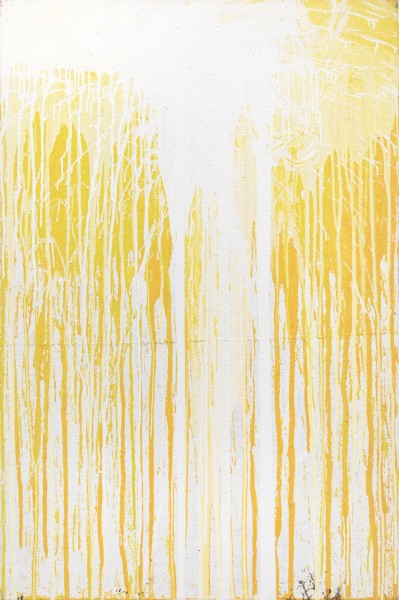RX&SLAG is delighted to present the fifth solo exhibition by Hermann Nitsch, a major figure in Viennese Actionism who died in 2022.
Born in Vienna, Austria, in 1938, Hermann Nitsch grew up in a climate marked by war and violence. This context had a profound influence on his work. From an early age, he immersed himself in poetry, graphic design and theatre, but also in religious, psychoanalytical and philosophical readings. In 1957, inspired by ancient myths and symbols from various civilisations, Hermann Nitsch developed what was to become his life's work: the Orgien Mysterien Theater. A veritable ritual theatre, it drew on a range of spiritual beliefs and traditions, combining Christian, pagan and mythological symbols in the broadest sense. The artist creates Dionysian ceremonies staged in the form of collective dramas, designed as experiences of trance, catharsis and communion, where gesture, matter and the body aim to reconnect deeply with the very essence of being.
He conceived his theatres in an Austria still marked by the repression of the Nazi past and sought to provoke a veritable collective catharsis, a way of releasing buried traumas, placing his art at the service of humanity. A profound humanist, his aim was to help people rise above themselves, to reach a moment of revelation and purity. His work, nourished by spirituality, is based on the Christian symbols and gestures with which he grew up, but also on the great founding myths of civilisations. By uniting these references, he seeks to reveal a universal dimension of the sacred, making it a common language that provides access to the light.
His art provokes an awareness of existence, calling on all the viewer's senses: sight, hearing, touch and smell, in an immersive and cathartic experience creating a Gesamtkunstwerk: a total work of art. His work is part of the Viennese Actionism movement, of which he became one of the pillars, pushing back the boundaries of performance art, between painting, music and theatre.
His Aktionen (“actions”) often take the form of rituals imbued with sacred symbolism, in which blood (which can be real or metaphorical) becomes pictorial and spiritual matter. In 1960, he began his first Malaktionen (“paintings actions”), marking the birth of his Schüttbilder: canvases marked by splashes of red paint, the colour of blood and sacrifice. He titled these early paintings Kreuzwegstationen (“Stations of the Cross”).
From then on, this colour occupied a central place in his work. For the artist, red is not just a religious symbol: it represents a vital, universal element shared by all cultures. It embodies both death and the intensity of life. This “intensity” is fundamental to his work: it runs through his canvases, striking, questioning, an awakening to being.
At the centre of some of his works is a white smock, a recurring element since the 1980s. Worn by Hermann Nitsch during his painting performances, this smock, bearing the artist's stigmata, is then hung like a T-shaped trophy on the canvas. It becomes a metaphor for kenosis, a Greek term referring to the act of emptying or stripping oneself of everything. In theology, kenosis refers to the renunciation of divine attributes. But beyond this symbolic interpretation, it seems above all to mark the artist's desire to inscribe his own presence at the very heart of the work, blurring the boundary between body and painting.
Although blood red is omnipresent in his work, it is not the only colour explored by Hermann Nitsch. During his 45th Aktion in 2002, yellow became his main colour and gradually evolved into a radiant yellow: “that of ripe wheat under the summer sun”, in the artist's words. This yellow intensifies until it becomes pure, almost blinding light. The colour is then no longer simply matter; it is transfigured into intense light and seems to attain a spiritual and sacred dimension: it is the light of resurrection and hope. This bright yellow interacts with the original red, and their encounter gives rise to orange, an ochre and solar hue that creates a link of continuity between the early bloody works and a brighter, almost sacred dimension. These recent canvases suggest a symbolic reversal: yellow triumphing over red, light triumphing over pain. Through this evolution of his colour palette, Hermann Nitsch once again puts his art at the service of humanity, offering colour as a path to revelation and a form of pictorial redemption.
